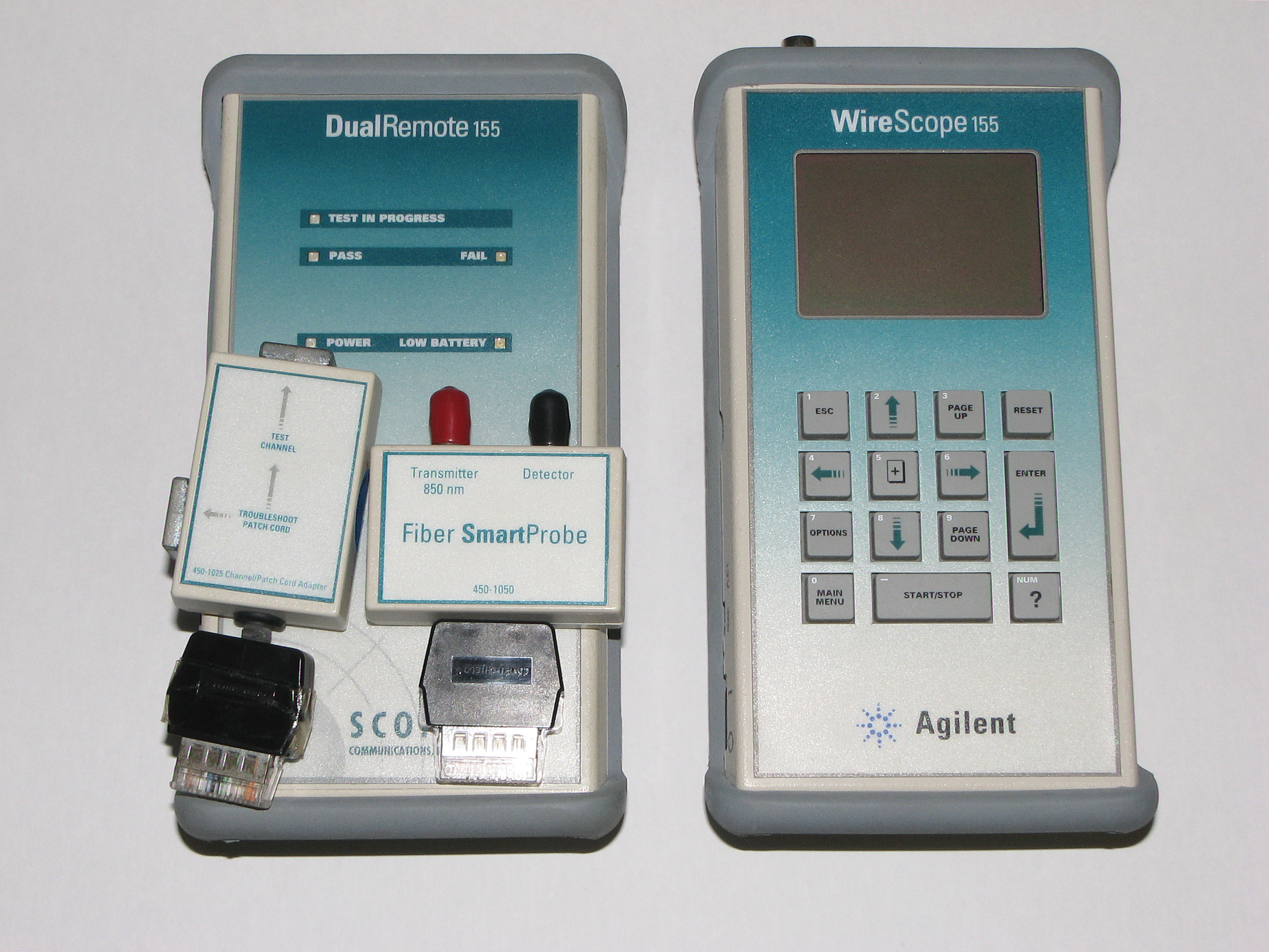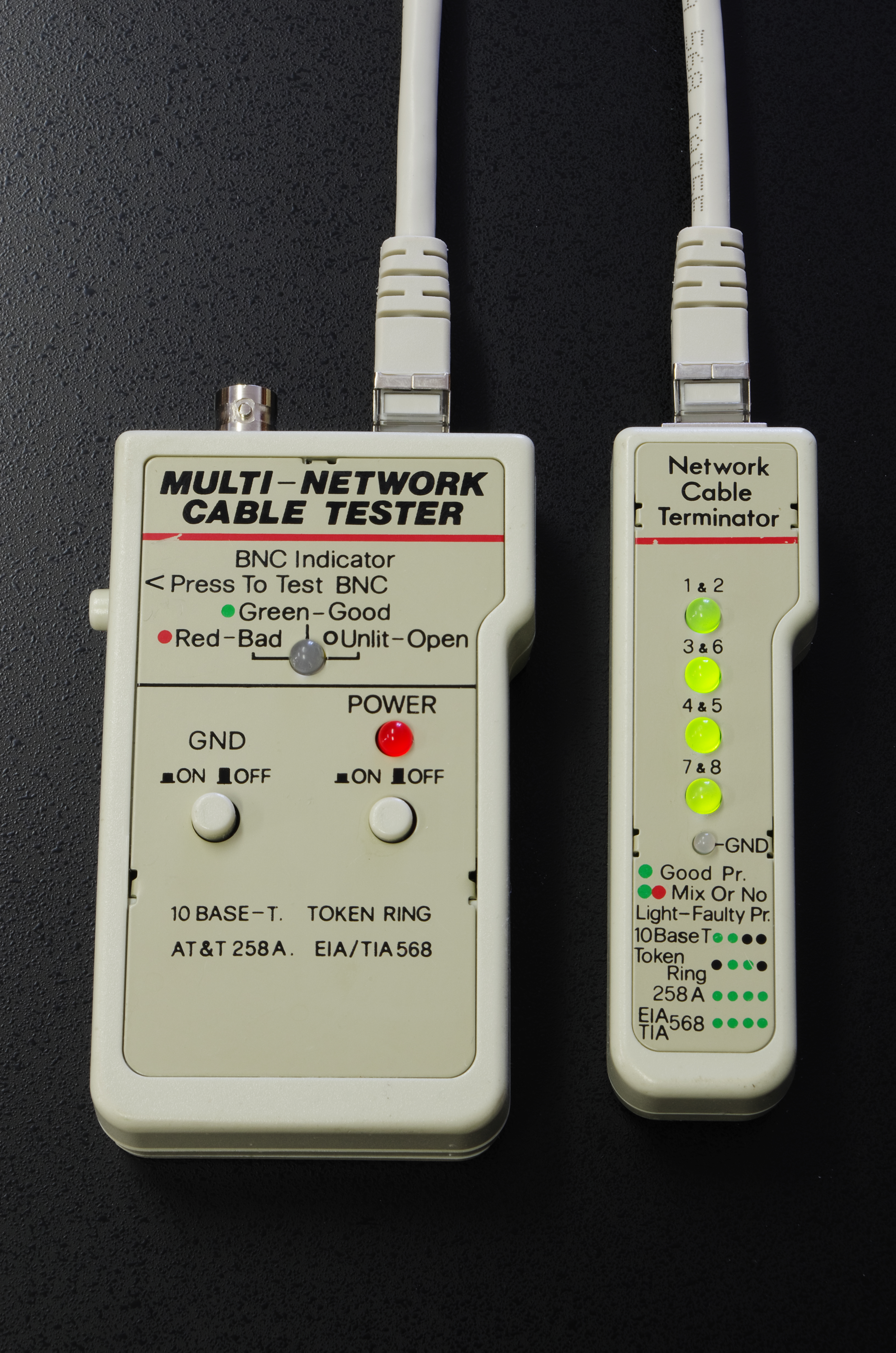Cable Tester on:
[Wikipedia]
[Google]
[Amazon]

 A cable tester is an electronic device used to verify the electrical connections in a signal cable or other wired assembly. Basic cable testers are
A cable tester is an electronic device used to verify the electrical connections in a signal cable or other wired assembly. Basic cable testers are

 A cable tester is an electronic device used to verify the electrical connections in a signal cable or other wired assembly. Basic cable testers are
A cable tester is an electronic device used to verify the electrical connections in a signal cable or other wired assembly. Basic cable testers are continuity tester
A continuity tester is an item of electrical test equipment used to determine if an electrical path can be established between two points; that is if an electrical circuit can be made. The circuit under test is completely de-energized prior to co ...
s that verify the existence of a conductive path between ends of the cable, and verify the correct wiring of connectors on the cable. More advanced cable testers can measure the signal transmission properties of the cable such as its resistance, signal attenuation, noise and interference.Terry William Ogletree, ''Upgrading and Repairing Networks'', Que Publishing 2004, , page 961
Basic tester
Generally a basic cable tester is a battery operated portable instrument with a source ofelectric current
An electric current is a stream of charged particles, such as electrons or ions, moving through an electrical conductor or space. It is measured as the net rate of flow of electric charge through a surface or into a control volume. The movin ...
, one or more voltage indicators, and possibly a switching or scanning arrangement to check each of several conductors sequentially. A cable tester may also have a microcontroller and a display to automate the testing process and show the testing results, especially for multiple-conductor cables. A cable tester may be connected to both ends of the cable at once, or the indication and current source portions may be separated to allow injection of a test current at one end of a cable and detection of the results at the distant end. Both portions of such a tester will have connectors compatible with the application, for example, modular connector
A modular connector is a type of electrical connector for cords and cables of electronic devices and appliances, such as in computer networking, telecommunication equipment, and audio headsets.
Modular connectors were originally developed for ...
s for Ethernet
Ethernet () is a family of wired computer networking technologies commonly used in local area networks (LAN), metropolitan area networks (MAN) and wide area networks (WAN). It was commercially introduced in 1980 and first standardized in ...
local area network
A local area network (LAN) is a computer network that interconnects computers within a limited area such as a residence, school, laboratory, university campus or office building. By contrast, a wide area network (WAN) not only covers a larger ...
cables.
A cable tester is used to verify that all of the intended connections exist and that there are no unintended connections in the cable being tested. When an intended connection is missing it is said to be "open". When an unintended connection exists it is said to be a "short" (a short circuit
A short circuit (sometimes abbreviated to short or s/c) is an electrical circuit that allows a current to travel along an unintended path with no or very low electrical impedance. This results in an excessive current flowing through the circuit ...
). If a connection "goes to the wrong place" it is said to be "miswired" (the connection has two faults: it is open to the correct contact and shorted to an incorrect contact).
Generally, the testing is done in two phases. The first phase, called the "opens test" makes sure each of the intended connections is good. The second phase, called the "shorts test" makes sure there are no unintended connections.
There are two common ways to test a connection:
# A continuity test
In electronics, a continuity test is the checking of an electric circuit to see if current flows (that it is in fact a complete circuit).
A continuity test is performed by placing a small voltage (wired in series with an LED or noise-producing c ...
. Current is passed down the connection. If there is current the connection is assumed to be good. This type of test can be done with a series combination of a battery (to provide the current) and a light bulb (that lights when there is a current).
# A resistance test. A known current is passed down the connection and the voltage that develops is measured. From the voltage and current the resistance of the connection can be calculated and compared to the expected value.
There are two common ways to test for a short:
# A low voltage In electrical engineering, low voltage is a relative term, the definition varying by context. Different definitions are used in electric power transmission and distribution, compared with electronics design. electrical safety codes define "low vol ...
test. A low power, low voltage source is connected between two conductors that should not be connected and the amount of current is measured. If there is no current the conductors are assumed to be well isolated.
# A high voltage
High voltage electricity refers to electrical potential large enough to cause injury or damage. In certain industries, ''high voltage'' refers to voltage above a certain threshold. Equipment and conductors that carry high voltage warrant spe ...
test. Again a voltage source is connected but this time the voltage is of several hundred volts. The increased voltage will make the test more likely to find connections that are nearly shorted since the higher voltage will cause the insulation of nearly shorted wires to break down.
Signal testers
More powerful cable testers can measure the properties of the cable relevant to signal transmission. These include the DC resistance of the cable, the loss of signal strength (attenuation) of a signal at one or more frequencies, and a measure of the isolation between multiple pairs of a multi-pair cable orcrosstalk
In electronics, crosstalk is any phenomenon by which a signal transmitted on one circuit or channel of a transmission system creates an undesired effect in another circuit or channel. Crosstalk is usually caused by undesired capacitive, in ...
. While these instruments are several times the cost and complexity of basic continuity testers, these measurements may be required to certify
Certification is the provision by an independent body of written assurance (a certificate) that the product, service or system in question meets specific requirements. It is the formal attestation or confirmation of certain characteristics of a ...
that a cable installation meets the technical standards required for its use, for example, in local area network cabling.
Optical cable testers
An optical cable tester contains a visible light source and a connector compatible with the optical cable installation. A visible light source is used, so that detection can be done by eye. More advanced optical cable testers can verify the signal loss properties of an optical cable and connectors,See also
*Time-domain reflectometer
A time-domain reflectometer (TDR) is an electronic instrument used to determine the characteristics of electrical lines by observing reflected waveforms.
It can be used to characterize and locate faults in metallic cables (for example, twisted pai ...
References
External links
* * {{curlie, Computers/Data_Communications/Testing_and_Tools/, Data Communications Testing and Tools Electrical test equipment Electronic test equipment